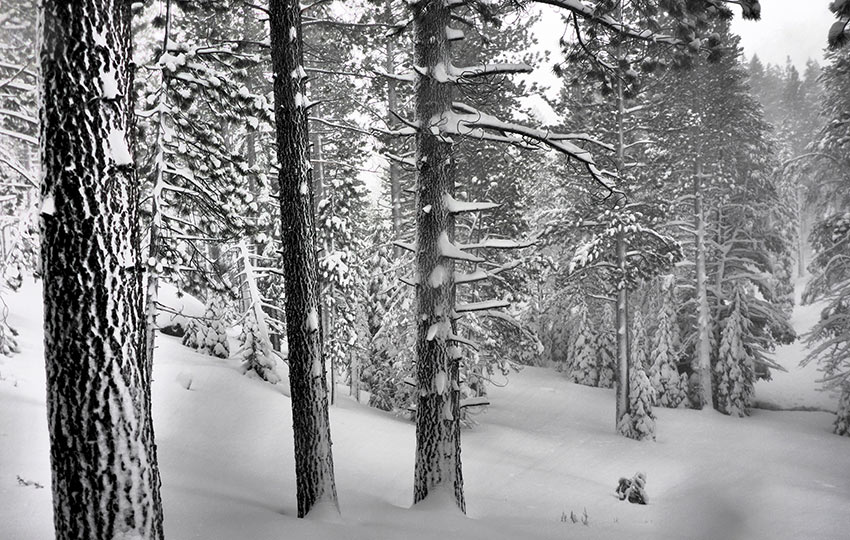
The mountaineering adage of “there’s no bad weather, only bad gear” holds true in many ways in cross-country skiing. But you could take that statement even further. Not only does choosing the correct cross country gear to run in challenging conditions help. But, modifying your attitude and technique will surely contribute toward having a quality cross-country experience regardless of when or where you ski.
In this article, I highlight ways in which I approach xc skiing in conditions that are less than ideal. Or, downright challenging.
Full disclosure … I’ve worked at a cross country ski resort near North Lake Tahoe since the winter of 2014-15. So I don’t have to pay to ski at the resort for which I work. But I’m there every weekend from November to April.
Support Tahoe Trail Guide with a financial contribution via PayPal (single contribution) or Patreon (reoccurring contributions). Your support of Tahoe Trail Guide is very much appreciated!

Where I live in South Lake Tahoe, there are very few groomed cross country resorts or areas. Therefore, the other half of winter I cross country ski in the backcountry.
My point is that I ski in the absolute best and worst conditions all winter long.
Is there such thing as a bad day of skiing?
Barring injury or catastrophe, I have a difficult time equating skiing with a bad day.
I realize that most people spend a lot of money in order to ski. This is true regardless of visiting a downhill or cross country ski resort. Psst … a cross–country ski area costs fractions less compared to a downhill resort. And there are no lift lines!
If the conditions aren’t perfect, it’s easy to feel like you got a bad deal (i.e. bad day of skiing).
Over the years, I’ve heard countless people complain about there being too much snow, too little snow, the snow being too icy, or that the snow was too soft.
Mostly all I can do is shrug my shoulders. Then, I explain that the resort is still developing the technology to turn on/off the weather so that it’ll coincide with the 9-to-5 work week.
Jokes aside, outdoor adventures will always be unpredictable due to the weather (and resulting conditions from past weather). This is the whole point of going on an outdoor adventure. This is what makes them adventures. And, this is why you want to experience them.
In the end, nobody wants to hear about your perfect vacation or your perfect life. It’s just not that interesting.
Instead, people want to hear about the adversity you faced and, more importantly, how you overcame it.
Bluebird powder days are the stuff of dreams when it comes to skiing. However, they’re not the norm no matter how much that social media influencer or ski resort marketing department tells you.
Have I ever had a bad day of cross country skiing?
Honestly, there’s only one experience that I would classify as having been “miserable.”
Soon after falling in love with xc skiing I inherited a pair of skate ski boots. I didn’t know how to skate ski at the time, but knew I would eventually use them. The mistake I made that caused my “miserable” ski experience was having the wrong boots. I had accidentally brought those skate boots instead of my classics to a groomed area near my home.
I was too inexperienced to know that skate boots absolutely do not function as a classic boot. They’re not flexible enough in the toes for diagonal striding. In addition, the area in which I skied had only groomed a skate lane (no classic tracks). And the whole track was basically a sheet of ice.
Since I already committed the time and money to ski, I just went for it.
Big mistake.
Had I been more experienced, I would’ve just skated on my classic skis. Not as fun, but functional enough to have made the trip worth my time. Instead, I spent about an hour floundering around the whopping 5 km of icy track before deciding enough was enough.
This is obviously not the worst example of a bad day of skiing, but it’s all I got.
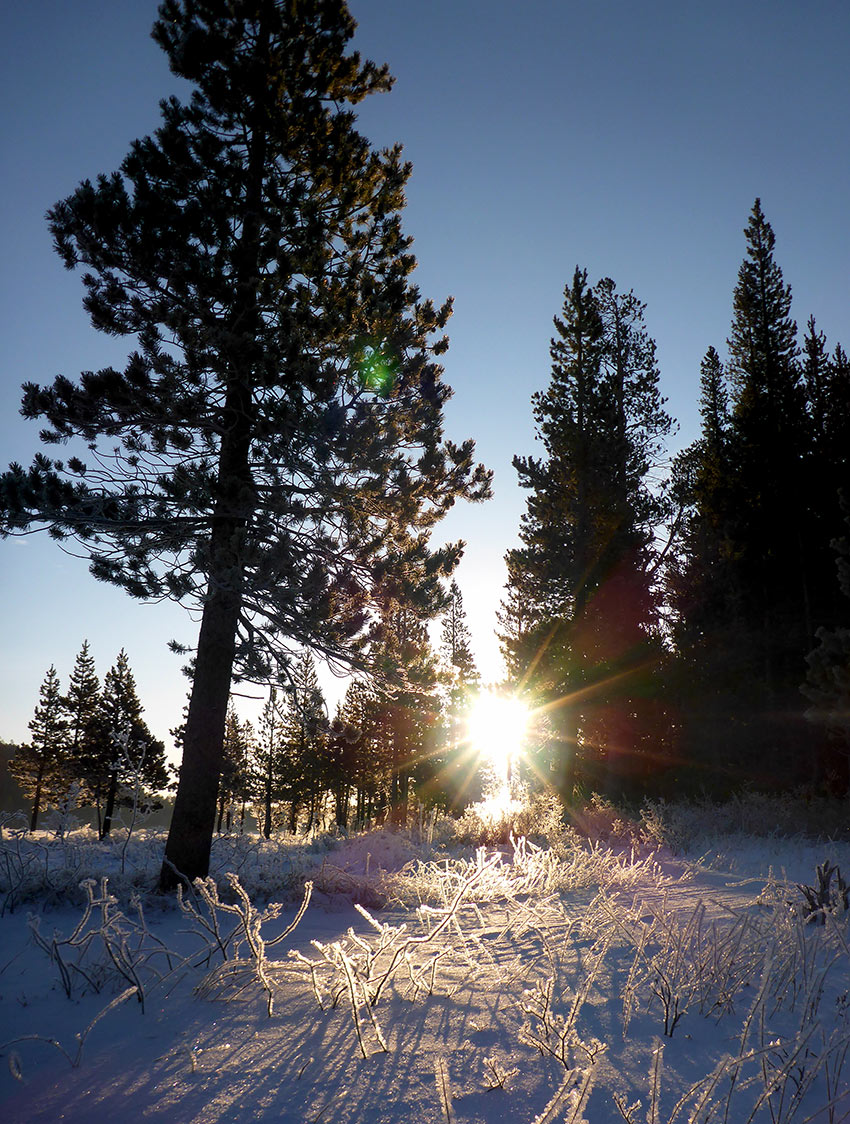
Ever since that day I learned to treat each day on skis as a unique experience from which to learn. Even with the wrong gear, could I adapt my technique enough to run the skis? Or, would it just be better to cut my losses and head to the coffee shop?
One morning I was skiing with a friend who, mid-session, realized he didn’t have any kick wax on his waxable skis! Why? Because he had cleaned them after his last race but forgot to add new grip wax (for our session). He laughed about it, and then just skate skied the rest of our session.
Pack the right gear. Then, double check it to ensure you actually have the correct gear before leaving the house.
Skiing Only in Ideal Conditions is a Fantasy
Although I have tons of experience backpacking throughout the year, I’ve only winter camped a handful of times. In March of 2016, I completed my first cross-country ski overnight tour. The route I skied was only 13 total miles, split over two days. However, I had such a blast that I planned to complete more overnight excursions the following winter.
Unfortunately, the snowpack in the Lake Tahoe region at the beginning of the 2016/17 winter was highly unstable. This was caused by a mix of big snowfalls followed by warm temps and torrential rain. This cycle happened twice between Thanksgiving and just after New Year’s Day.
Then, more massive snowfalls continued to fall routinely during the rest of the winter. We all appreciated the “Snowpocalypse,” especially after so many winters of drought. However, it resulted in dangerous backcountry conditions for the entire season (i.e. less than ideal conditions).
Needless to say, I only made the commitment to complete one overnight cross-country ski tour that season.
In spite of not being prepared to ski long distances or stay overnight in the backcountry (due to the unstable snowpack), I did manage to log numerous days of xc skiing thanks to all of that snow.
The beauty of that season was that I experienced a broad range of snow conditions.
Like many people who are proficient at a thing, I also tend to shy away from performing in less than ideal conditions.
Once you alpine ski or snowboard epic powder, it’s hard to get excited about hitting the groomers. But if you want to be safe and have fun in the backcountry, don’t succumb to this mental pitfall.
Life is seldom an “ideal condition,” and everything is amplified (for better or worse) in the backcountry. If you’re not mentally and physically prepared to deal with the conditions before you, catastrophe can strike.
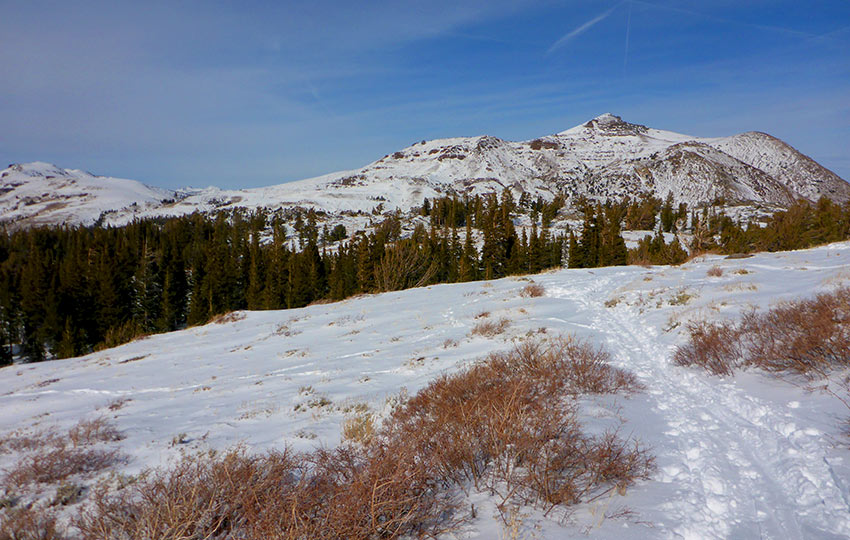
Unlike our minds, which absorb, process, and assimilate information in many ways, the body can’t know until it experiences. You can imagine being cold by looking out the window and watching the snow pile up. However, imagining will never fully prepare your body for actually being exposed to that cold weather.
So based on the unstable conditions of the 2016/17 season, I shelved my plans for overnight cross-country ski tours.
That didn’t mean I didn’t prepare for the adventures, though. In fact, I used the diverse winter conditions to embrace beneficial training experiences. Namely, I began to focus more on the concept of frequency over duration with regard to my training and preparation.
Thanks to my job at a cross-country ski resort in Truckee, CA, I have access to groomed terrain and expert skiers. And, those co-workers and friends have become great resources and mentors.
Leading up to the 2016/17 season, I was part of a trail maintenance crew at the cross-country ski area. So, I could test out clothing and gear in adverse weather and under physically demanding conditions. And, I could get acclimated to being outside all the time.
Once we opened, I skied before work and then again during my lunch breaks. This gave me the chance to experience different snow conditions and temperatures during the same day. I also built strength and balance while honing my diagonal striding technique.
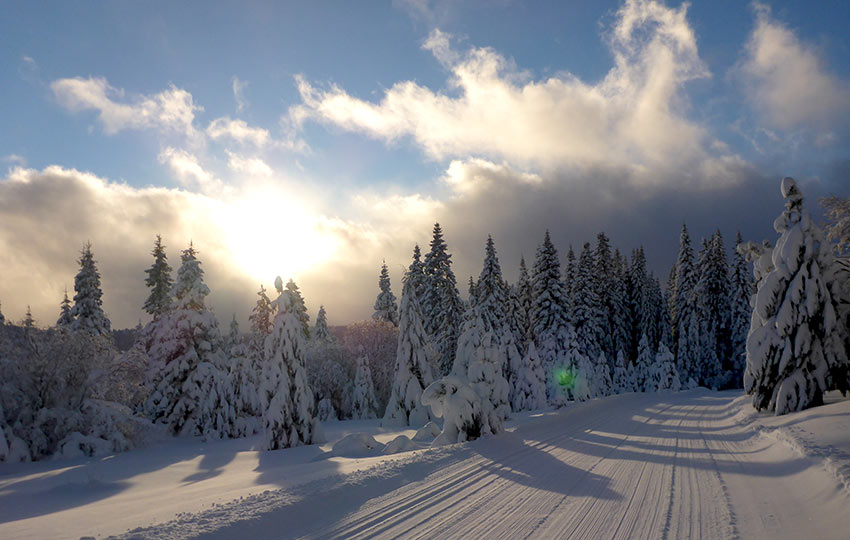
Most of my co-workers are instructors, ski technicians, and racers in the cross-country skiing industry. Many of them are also experienced backcountry skiers and mountaineers (to one degree or another). I took the opportunity to riddle them with questions about technique, ski maintenance and preparation, and backcountry travel.
I watched training videos and read books about cross-country skiing and mountaineering.
One book that I recommend is called Two Planks and a Passion #ad. It’s basically an encyclopedia of mankind’s history of skiing. The book is a bit on the dry side. However, it provides context for our use of skis as tools for survival rather than just for a fun pastime on the weekends.
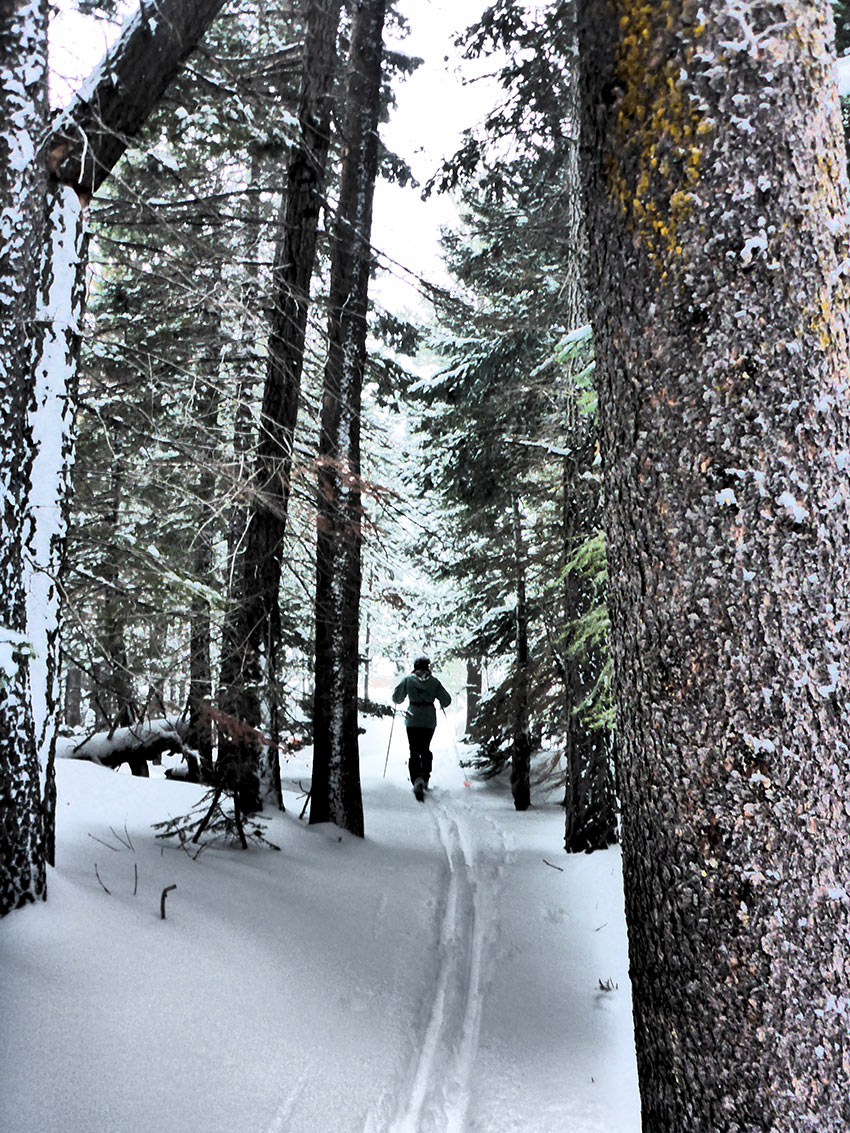
When not at work, I ski near my home as often as time and conditions permit. And, since there aren’t any groomed xc ski areas nearby I ski off-track and in the backcountry.
That’s fine with me, particularly since my home is near open space. I can literally ski from my front door. When traveling off-trail, I’ll often ski between 2-5 miles. Despite their brevity, however, those shorter sessions provide me with tons of valuable experience and information.
And this is what I typically use these shorter sessions for — recording information into my body.
- To what degree will my diagonal striding technique deteriorate when I’m off-track? When I’m tired? When I’m caught in whiteout conditions?
- How long will it take me to travel a mile or two in six inches of fresh snow? What about 12 inches?
- How many of layers of clothing do I need when it’s snowing, 26 degrees, and I’m skiing on flat terrain? What about the same situation and distance but with an elevation gain of 1,500 or more feet?
Ultimately you just cannot know the answers to these questions and scenarios until you experience them firsthand. But it’s better to do so under more controlled circumstances (i.e. close to home or vehicle) rather than when you’re miles deep in the backcountry and get caught in a blizzard.
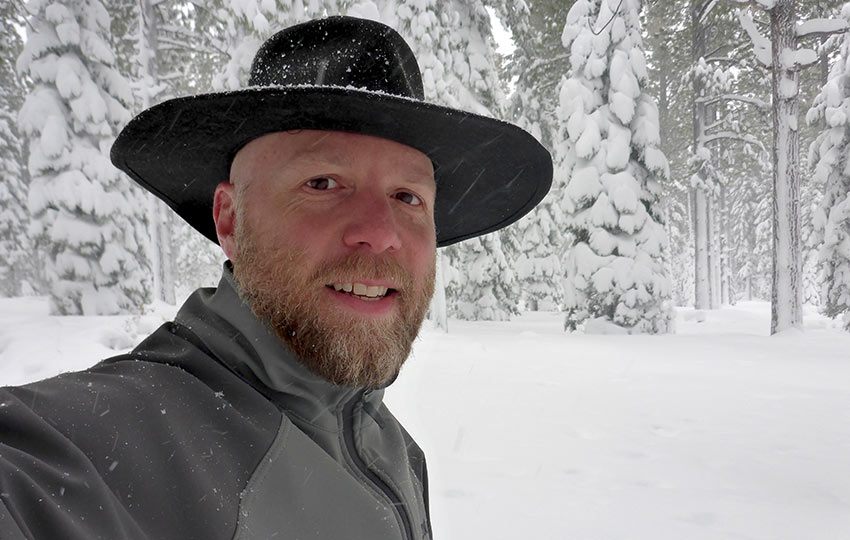
The week of January 9, 2017, provided multiple feet of fantastic snow. All of that snow set the Lake Tahoe region up for a long winter season.
As I waited for the snowpack to stabilize, and in-between numerous sessions of shoveling and snowplowing, I skied short distances from home. This enabled me to build into my body the information and experience I need to make effective decisions and calculations for safe backcountry travel.
Few of my ski sessions lasted for more than an hour. However, my focus for the season was to train using frequency over duration.
Ultimately I wound up skiing about 75 days that season, and my technique and experience progressed exponentially as a result.
If you’re looking for some inspiration for learning downhilling technique with cross-country ski gear (in the backcountry), I recommend reading Cross-Country Downhill #ad. Although it’s dated (published c. 1987), it provides wonderful philosophy about cross-country skiing off the beaten path.
There’s also a lot of technical information regarding learning the Telemark turn on lighter cross-country touring gear. I highly recommend reading this book for those of you looking to cross-country ski in the backcountry.
Keep in mind, though, that this book is written with a more advanced mountain adventurer in mind. Follow the Amazon link and you should be able to find a used copy.
Cross-Country Skiing Explained Articles and Videos
Please note that I wrote and produced the Cross-Country Skiing Explained series of articles and videos with the beginner and intermediate cross-country skier in mind. This is the demographic for whom I most often serve(d) while working in the outdoor recreation industry at Lake Tahoe. I basically treat these articles and videos as extensions of the conversations that I have (had) with those customers.
That said, expert skiers probably could take away something of value from these resources. Just know that I don’t address race-oriented philosophy, technique, or gear selection.
Considerations for buying cross-country ski gear (new and beginner xc skiers)
- Intention, Types of XC Skis, and Whether to Buy New or Used (Part 1)
- How Much Gear to Acquire, Evaluate Your Commitment, Value of Taking XC Ski Lessons (Part 2)
- Can One Set of Classic Cross-Country Skis Work for Groomed and Off-Track XC Skiing? (Part 3)
- Can I Use One Set of XC Ski Boots for All of My Cross-Country Skiing Needs? (Part 4)
- Overview of Off-Track and Backcountry Cross-Country Ski Gear
- Invest in Technique More than Gear
Classic Cross-Country Ski Components
- Introduction to Classic Cross-Country Skis (Part 1)
- Geometry of Classic Cross-Country Skis (Part 2)
- The Grip Zone of Classic Cross-Country Skis (Part 3)
- Types of Bindings for Classic Cross-Country Skiing (Part 4)
- Ski Boots for Classic Cross-Country Skiing (Part 5)
- Classic Cross-Country Ski Poles (Part 6)
- FAQs about Classic Cross-Country Skiing
Waxing Your “Waxless” Cross-Country Skis (for beginner and intermediate xc skiers)
- Introduction to Waxing Your Waxless XC Skis
- Step-by-Step Waxing Tutorial
- FAQs About Waxing Your Waxless XC Skis
Cross-Country Skiing Techniques, Demonstrations, and Related Concepts
- Outdoor VLOG (emphasis on the cross-country skiing experience)
- Cross-Country Skiing in Challenging Conditions
- Considerations for Winter Adventure in Lake Tahoe’s Backcountry
- Using the Side-Step and Herringbone Techniques in the Backcountry
- 10 Tips for Spring Cross-Country Skiing in the Backcountry
- 5 Reasons to Love Spring Cross-Country Skiing
- Considerations for Cross-Country Skiing During the Fall and Early Winter
- Discussing the Goal of Becoming a Better Cross-Country Skier and Embracing Backcountry and Groomed Terrain in Pursuit of that Goal
- The Cross-Country Skiing Experience: Immersing Yourself in Winter
I particularly enjoyed the positive mindset aspects of your article (perhaps summed up as: There are no bad conditions, only bad attitudes). Speaking of less than ideal snow conditions, I’m going to be spending the summer in the Santa Cruz mountains. Do you have any suggestions on backcountry roller skis?
Hey Roger!
Thanks so much for the kind words. And, yep, you pretty much hit the nail on the head — there are no bad conditions, just bad attitudes … and occasionally improper gear selection, of course — haha 🙂
As far as roller ski recommendations go, I’m not super experienced in that department. I’ve only gone a few times, and I wrecked once which resulted in some nasty road rash (that took forever to heal!). That experience then soured me on roller skiing for the time being. Not that I wouldn’t do it again, just that I’d be more armored up next time! I’ve heard the best protective gear for roller skiing basically comes from the roller blading section of outdoor recreation gear.
The model I borrowed from a friend was for skate skiing and featured larger wheels (helps overcome divots in the asphalt and to roll over smaller rocks and debris) as well as a friction option (more friction aids in slowing you down on the descents or even the flats if you’re not super confident in your skills). Prior to trying it out, I spoke with one of my xc ski mentors about roller skiing. She recommended using skate ski roller skis rather than classic ski versions. The reason being is that the mechanism to replicate the diagonal stride technique is basically a wheel stop (essentially prevents the wheels from rolling backwards). The slippery slope to using the classic version is that it can mask poor technique because you’re pretty much guaranteed never to slip back. On snow, obviously, you’d never have that guarantee (hence the need for proper technique). Also, people that I know who roller ski will often go with friends and do a shuttle option where they will ski on the flats and uphill, then drive back down (to avoid the steep descents). There are no breaks on roller skis.
Anyway, I’d take a look at what pro athletes use and maybe contact xc ski clubs who train in the summer. Far West Nordic (http://farwestnordic.org/) and the Auburn Ski Club (http://auburnskiclub.com/asctc/) are two clubs in the Tahoe Region that can probably provide more information. They’re both very race-oriented outfits and most likely have many members who roller ski during the summer.
Good luck and, if you have the time, let me know what you ultimately decide!
Me, I tend to spend my time off during the summer wandering through the forests and mountains looking for birds and wildflowers 🙂
Informative piece for us occasional skiers. Loved the video, and the comments about the sombrero!
Thanks for the feedback, Joan!